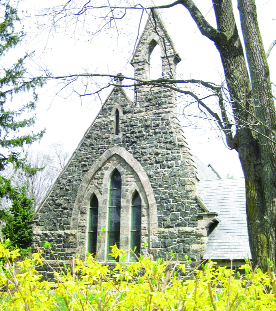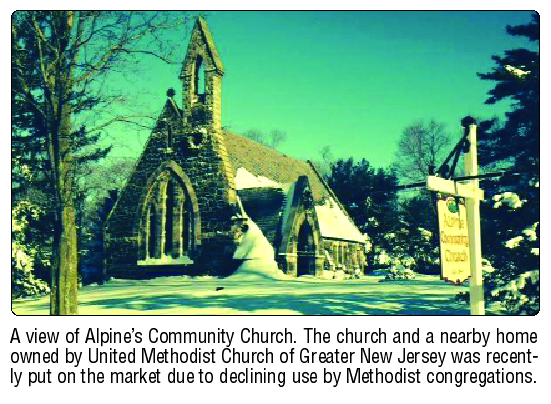
BY MICHAEL OLOHAN
OF NORTHERN VALLEY PRESS
ALPINE, N.J.—A local historic landmark for over 150 years being sold to the highest bidder has members of its former congregation leading a fundraising drive in hopes of purchasing it back.
Meanwhile, former members of Alpine Community Church, a previously Methodist congregation who broke away from the Methodists and consider themselves non-denominational, say they are appealing to residents concerned about preserving a piece of Alpine history to contribute funds in hopes of purchasing the property, currently listed for $3.45 million on Zillow.
The church, and an accompanying community house and parsonage on two lots comprising 3.19 acres, went up for sale in December and has received several offers, according to a real estate agent handling the sale.
“The sale of the property on Closter Dock Road is being managed by professional Realtors. We will follow their guidance in making decisions about the sale and complying with local regulations including zoning laws about the property,” said Carolyn Conover, spokesperson for United Methodist Church of Greater New Jersey,” via email Jan. 16.
Conover declined to discuss any sales options, including suggestions the Methodist group might market the church property apart from an adjoining parsonage and small community center house on a nearby lot of the three-plus-acre property.
Ownership battle
While the fate of the church has been debated for at least six years, some former church members—who have formed the Community Church of Alpine congregation—say the borough could also be doing more to help purchase—or at least preserve—the historic church originally designed by J. Cleveland Cady, architect of the Metropolitan Opera.
In 2015, about 20 members of Alpine Community Church fought a legal battle for ownership and “self-governance” of the land and property with United Methodist Church of Greater New Jersey and lost.
According to a statement issued in June 2015, United Methodist Church officials met with Alpine Community Church members to “explore ways that the church can move forward in the wake of a court ruling about property rights.”
Those were not successful, said Conover.
Conover told Northern Valley Press in December that “we never want to see a church close; however, when it does, it is our responsibility to steward the resources entrusted to The United Methodist Church to support mission and ministry in the region and around the world.”
‘Many showings’ of church
David Price, a realtor with Sotheby Prominent Properties Realty in Alpine, said the property has “definitely had many showings, at least three to four times a week,” including verbal and written offers.
He said other religious congregations have considered the property recently but declined to be more specific about potential purchasers or bids.
Community Church of Alpine Board President Charles Yannetti said the non-denominational congregation, which previously used Alpine Community Church, had reached out at least a year ago to Alpine Mayor Paul Tomasko to suggest a possible local bond issue to purchase the historic church property.
Yannetti claimed Tomasko was opposed to a taxpayer-financed option to acquire and protect the church at the time.
Currently the Community Church of Alpine meets in space provided by the local Boy Scouts, said Yannetti, but would love to purchase and preserve the historic property via fundraising efforts to residents who can contribute donations to save a piece of history.
Yannetti claimed he heard the mayor has been trying to facilitate a possible deal between the United Methodist Church and a religious entity to enable a church organization to continue to use the historic church for religious purposes.
Tomasko told Northern Valley Press he has “not approached anyone” regarding the ongoing sale of the church property. He said it was his understanding “negotiations are moving in a positive direction with a high likelihood of success” that the church remains with a religious organization.
Asked what might happen if a private buyer rather than another religious congregation purchased the property, the mayor said “we don’t see it going that way. We’ve made it known that it is our [mayor and council] hope that it will continue to be a house of worship in our town, which is also the only religious edifice and most historic property in our town,” Tomasko noted.
Tomasko said a letter from the mayor and council went to United Methodist Church of Greater New Jersey expressing its hopes that the church remains with a religious congregation.
He said no response was received to its letter.
Tomasko said the Planning Board serves as the borough’s historic preservation commission but does not regularly meet.
He said should a private developer purchase the property, the council may convene the historic commission and address that situation “head on and aggressively.”
“We’ll cross that bridge when we come to it,” said the mayor.
Yannetti said he hoped to work with the mayor and local officials on efforts to keep the structure operating as a church.
Church not protected?
Yannetti said he was concerned that the church, built on bedrock and without an operating restroom, might be a hard sell to a religious group but that a deep-pocketed investor might purchase the property and possibly demolish the historic structure to put up a mansion.
While many properties in Alpine—including Alpine Community Church—reside in an Upper Closter/Alpine historic district, the district designation provides little protection should a property owner wish to demolish the property, say local historians.
Only designating a property as historical through a local process of nomination and designation may ultimately protect a historic structure’s facade and its historical elements.
Although Alpine passed an ordinance in December 2016 creating a historical preservation commission—which can recommend such designations—it was not exactly clear why the commission has not met recently.
Although the church is listed on state and national historic registers recognizing its historic characteristics, those listings do not provide protection against demolition.
Protecting landmarks
Dave Wall, a member of Tenafly’s Historic Preservation Commission, which has existed since 1988, said historic preservation commissions derive legal power from the state’s Municipal Land Use Law that gives them the power to identify and protect local landmarks.
Tenafly’s local commission has designated many properties but recently delayed four downtown designations when a property owner threatened to shutter its local theater permanently had the council voted to designate the property as historic.
“Presence on the State and National Registers seems more impressive than landmark recognition by a municipality and may more quickly get one donations and matching funds. However, landmark designation by the municipality may be more important,” emailed Wall discussing the importance of local commissions’ power to designate and protect historic properties.
“Local landmark designation can stop the private owner or private developer [from demolishing a historic property],” he added.
‘Alpine itself’
Yannetti, in a brief essay on the church titled the “The Cornerstone of Alpine History,” wrote “It is said, that the structure of the Alpine Community Church, is of Alpine itself.”
“The stone is trap rock from the bottom of the Palisades, and its hand-hewed wooden beams are from timbers located within the town,” he wrote. “The pews are all from trees cut and shaped in Alpine, and the pulpit was made from a large butternut tree, built by [local contractor Stephen] Hyde, himself. All of the wood carvings found inside the Church were provided by a New York artist, known as Kilson, who was introduced to the project by [designer] J. Cleveland Cady.”
The church was also depicted by illustrator Thomas Nast— who used it on Christmas cards he created in the late 1800s and the church eventually became known as “the Christmas Church,” drawing visitors to Alpine from near and far to view the famous landmark.

